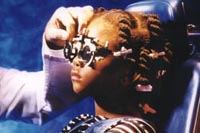Eyeglasses and Contact Lenses
Lenses for correcting or improving vision
There are 2 types of lenses prescribed for correcting or improving vision. These include:
-
Eyeglasses. Eyeglasses are the most common form of eyewear used to correct or improve many types of vision problems. They consist of a frame that holds 2 pieces of glass or plastic to correct refractive errors. Refractive errors can include trouble seeing far away (nearsightedness or myopia) and trouble seeing close up (farsightedness or hyperopia). They can also include blurring due to an irregularly shaped cornea (astigmatism). Eyeglasses work by adding or subtracting focusing power to the cornea and lens.
-
Contact lenses. Contact lenses are worn directly on the cornea. Like eyeglasses, contact lenses correct refractive errors. They do this by adding or subtracting focusing power to the cornea and lens.
How to read an eyeglass prescription
The lens power of eyeglasses is measured in diopters. This measurement reflects the amount of power needed to focus images directly onto the retina. When looking at an eyeglass prescription, you will see the following abbreviations:
The eyeglass prescription may also have these measurements:
-
Sphere. This number reflects how much nearsightedness or farsightedness.
-
Cylinder. This number shows the amount of astigmatism (an irregularly shaped cornea which causes blurring).
-
Axis. This number measurement describes the direction of the astigmatism in degrees.
Bifocal is additional power in the lens. It has an additional measurement listed on the prescription as "add" to show the strength of the lens.
What are the different types of eyeglass lenses?
The type of lenses used in eyeglasses depends on the type of vision problem and may include:
-
Concave lenses. These are thinnest in the center. The numerical prescription in diopters is always marked with a minus (-) symbol. These lenses are used to correct nearsightedness (myopia).
-
Convex lenses. These lenses are thickest in the center, like a magnifying glass. They are used to correct farsightedness (hyperopia). The numerical prescription in diopters is always marked with a plus (+) symbol.
-
Cylindrical lenses. These curve more in one direction than in the other. They are used to correct astigmatism.
Eyeglasses for children
If your child is old enough, let them play an active role in choosing their own glasses. Think about the features below when buying eyeglasses for children:
-
Shatterproof and impact-resistant lenses, especially for children who play sports
-
Scratch-resistant coating on the lenses
-
Spring-loaded frames that are less likely to be bent or warped
-
Silicone nose pads that prevent glasses from slipping
-
Earpieces that wrap around the ear (cable temples) are advised for children under 4 years. Straps may also be advised to hold the glasses in place.
Facts about contact lenses
About 45 million Americans wear contact lenses. About 9 out of 10 people who wear contact lenses use soft lenses. In general, there are 2 types of contact lenses:
-
Rigid, gas-permeable lenses
-
Soft, water-absorbing lenses
Reading a contact lens prescription
A contact lens prescription includes more information than an eyeglass prescription. Special measurements are taken of the curvature of the eye. In addition, your child's healthcare provider will determine if their eyes are too dry for contact lenses. The provider will also see if there are any corneal problems that may prevent your child from wearing contact lenses. Trial lenses are often tested on the eyes first to make sure of the correct fit.
The contact lens prescription often includes:
Eye care specialists must, by federal law, give you a copy of your contact lens specifications.
Protect your child's eyes from the sun
Parents know they need to protect their children's skin from harmful sun rays. But many forget that the eyes need to be protected, too. Nearly 5 out of 10 American parents don’t regularly provide their children with sunglasses that protect their eyes from the sun's ultraviolet (UV) rays. Sun exposure may set children up for possible vision problems later in life.
The sun can cause sunburned corneas, cancer of the eyelid, cataracts, and macular degeneration, among other problems. In addition, children are more susceptible because their lenses don’t block as much UV as adult lenses. Children also tend to spend more time outdoors than their parents, often in places where there is a lot of sun reflection. These include beaches, pools, and amusement parks. It is also important for your child to wear sunglasses in the snow as well. Most UV eye damage is the result of years of exposure.
Protecting a child's eyes from the sun is simple:

Photograph used by permission of the National Eye Institute, National Institutes of Health